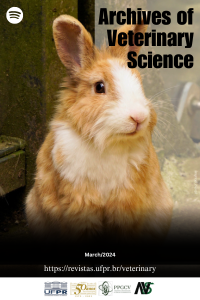Cocoa intoxication in domestic and street dogs: A comparative study
DOI:
https://doi.org/10.5380/avs.v29i1.92922Palavras-chave:
cocoa intoxication, street dogs, domestic dogsUnResumo
Chocolate intoxication can be life-threatening to dogs and cats with high morbidity and mortality. The current study aims to compare the toxic effect of dark chocolate on domestic dogs versus street dogs. Eighteen male dogs were used in this study, nine of each of domestic dogs and street dogs. The experiment continued for seven consecutive days. After three days, blood samples were collected as a control, and one dog from each group was sacrificed for negative control histopathological purposes. The same animals of both groups received a mixture of the standard diets and cocoa powder (1g / Kg BW / day) for four days. Clinical signs appeared faster in domestic dogs than in street dogs. Liver enzymes and oxidative stress indicators were elevated after four days in both street dogs the domestic dogs but not in their control groups. Furthermore, there was a significant increase in lipid profile except for HDL in the groups treated with cocoa compared to the control groups. The same results were noticed regarding total protein, urea, and creatinine since they significantly increased against their controls. In conclusion, cocoa is toxic to both domestic and street dogs in the same way except for the starting of the clinical signs where the domestic dogs were affected earlier than street dogs.
Referências
Aguilar DDLJ, Borges CR. Evaluation of oxidative stress in biological samples using the thiobarbituric acid reactive substances assay. J Vis Exp., 12:(159);61122, 2020.
Baum N, Dichoso CC, Carlton CE. Blood urea nitrogen and serum creatinine. Physiology and interpretations. Urology, 5:(5);583-588, 1975.
Cortinovis C, Caloni F. Household food items toxic to dogs and cats. Front Vet Sci. 3: 26, 2016. https://www.frontiersin.org/articles/10.3389/fvets.2016.00026/full
Erwanas A, Chandrawathani P, Premaalatha B, Zaini C, LILY RM, Jamnah O, Kumutha M, Norashikin M, Norazura A, Niny F. Parasitic infections found in pet and stray dogs in ipoh, malaysia. Malaysian Journal of Veterinary Research, 5:(1);27-34, 2014.
Finlay F, Guiton S. 2005. Chocolate poisoning. Bmj. Copyright © BMJ Publishing Group Ltd., 2005. 633 p.
Flohé L, Günzler WA. Assays of glutathione peroxidase. Methods Enzymol. 1984. p.114-121.
Gwaltney-Brant S. Chocolate intoxication. J Vet Med. 96:(2);108-111, 2001.
Gwaltney-Brant S. Chocolate Toxicosis in Animals - Toxicology - MSD Veterinary Manual. 2021. https://www.msdvetmanual.com/toxicology/food-hazards/chocolate-toxicosis-in animals?query=chocolate%20poisoning. accessed in: 06/10/2023
Haydock S. Chapter 11 - drug dependence. In: Bennett PN, Brown MJ, Sharma P, editors. Clinical pharmacology (eleventh edition). Oxford: Churchill Livingstone. 2012. p.136-159.
Hudd A. Chocolate poisoning in the dog. Veterinary Nursing Journal, 12:(2);54-55, 1997.
Jalil AM, Ismail A. Polyphenols in cocoa and cocoa products: Is there a link between antioxidant properties and health? Molecules,13:(9);2190-2219,2008. https://doi.org/10.3390/molecules13092190
Kalkofen UP. Intestinal trauma resulting from feeding activities of ancylostoma caninum. The American Journal of Tropical Medicine and Hygiene, 23:(6);1046-1053, 1974.
Luiz JA, Heseltine J. Five common toxins ingested by dogs and cats. J Compend Contin Educ Vet., 30:(11);578-587, 2008.
Miró G, Mateo M, Montoya A, Vela E, Calonge R. Survey of intestinal parasites in stray dogs in the madrid area and comparison of the efficacy of three anthelmintics in naturally infected dogs. Parasitology Research, 100:(2);317-320, 2007.
Okiyama DCG, Soares ID, Cuevas MS, Crevelin EJ, Moraes LAB, Melo MP, Oliveira AL, Rodrigues CEC. Pressurized liquid extraction of flavanols and alkaloids from cocoa bean shell using ethanol as solvent. Food Research International. 114;20-29, 2018.
Osweiler G, Wilkins. Over-the-counter drugs and illicit drugs of abuse. The National Veterinary Medical Series. Toxicology. Philadelphia: Williams. 1996. p.303-313
Salma SA, Nawras AA, Iqbal AA-R. Physiological study of dark cocoa intoxication between rabbits and local dogs. Journal of Pharmaceutical Negative Results, 13:(3);698-702, 2022.
Stidworthy MF, Bleakley JS, Cheeseman MT, Kelly DF. Chocolate poisoning in dogs. Vet Rec., 141:(1);28, 1997.
Trasviña-Muñoz E, López-Valencia G, Centeno PÁ, Cueto-González SA, Monge-Navarro FJ, Tinoco-Gracia L, Núñez-Castro K, Pérez-Ortiz P, Medina-Basulto GE, Tamayo-Sosa AR. Prevalence and distribution of intestinal parasites in stray dogs in the northwest area of mexico. Austral journal of veterinary sciences, 49:(2);105-111, 2017.
Weingart C, Hartmann A, Kohn B. Chocolate ingestion in dogs: 156 events (2015-2019). J Small Anim Pract., 62:(11);979-983, 2021.
Downloads
Publicado
Como Citar
Edição
Seção
Licença
Autores que publicam nesta revista concordam com os seguintes termos:
- Autores mantém os direitos autorais e concedem à revista o direito de primeira publicação, com o trabalho simultaneamente licenciado sob a Creative Commons - Atribuição 4.0 Internacional que permite o compartilhamento do trabalho com reconhecimento da autoria e publicação inicial nesta revista.
- Autores têm autorização para assumir contratos adicionais separadamente, para distribuição não-exclusiva da versão do trabalho publicada nesta revista (ex.: publicar em repositório institucional ou como capítulo de livro), com reconhecimento de autoria e publicação inicial nesta revista.
- Autores têm permissão e são estimulados a publicar e distribuir seu trabalho online (ex.: em repositórios institucionais ou na sua página pessoal) a qualquer ponto antes ou durante o processo editorial, já que isso pode gerar alterações produtivas, bem como aumentar o impacto e a citação do trabalho publicado.














